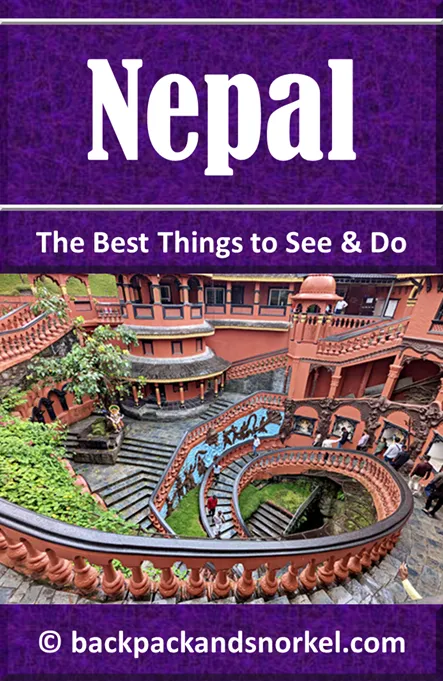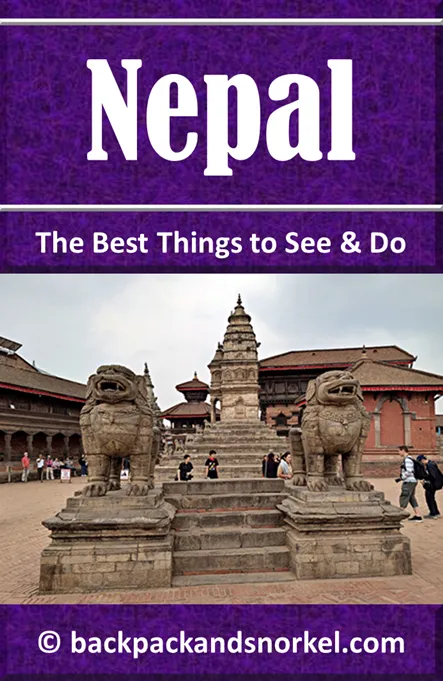Narayanhiti Palace Museum: Your Guide to Nepal's Royal History - Nepal Purple Travel Guide
(map, reviews, website)
This is Premium Content! To access it, please download our
Backpack and Snorkel Purple Travel GuideNarayanhiti Palace Museum was the official residence of the Shah kings until the 2001 royal massacre wiped out the royal family, and ultimately led to the abolition of the monarchy in 2008. The palace was converted into a museum and opened in 2009 as the Narayanhiti Palace Museum.
Here at Backpack and Snorkel Travel Guides, we typically promote self-guided walking tours.
But we realize that not everybody likes to walk by themselves in a foreign city. So, just in case that you rather go with ab guide: NO PROBLEM! Please see the Viator tours below.
free GuruWalk tours
paid Viator tours
The Origin of the Name Narayanhiti Palace Museum
The name ‘Narayanhiti’ is a blend of two Sanskrit words: ‘Narayana’, referring to the Hindu god Vishnu (the protector), and ‘Hiti’, meaning water spout. Legend has it that Lord Vishnu once rested near a spring in this area (located to the east of today’s main entrance in the precincts of the palace), lending the site its sacred name. This connection to divinity underscores the historical importance and auspiciousness of the location chosen for the royal palace.
History of the Narayanhiti Palace
Before the grand palace we see today, the site hosted smaller palatial buildings possibly dating back to the Malla period (12th–18th centuries). These earlier palaces were homes to nobility and were situated along an important ceremonial route that linked Kathmandu’s urban centers with royal and religious destinations.
However, much of the original structure was damaged by the devastating 1934 Nepal–Bihar earthquake, but repairs and additions were made afterwards.
The current palace was constructed in 1963 under King Mahendra, the father of King Birendra. The design was commissioned by Benjamin Polk, an American architect based in India, who fused traditional Nepali aesthetics with 20th-century palace planning. It features Nepali-style gables and motifs, but also broad halls and expansive interiors suitable for diplomatic functions and royal life.
Narayanhiti Palace became the official residence and administrative center for Nepal’s monarchs, especially during the constitutional monarchy era (post-1951).
The palace symbolized Nepal’s attempt to modernize while holding on to royal traditions, and it was a venue for state events, royal weddings, coronations, and meetings with international dignitaries.
Perhaps the most pivotal and tragic chapter in Narayanhiti's history occurred on June 1, 2001, during the infamous Nepalese royal massacre.
According to official reports:
Crown Prince Dipendra allegedly killed King Birendra, Queen Aishwarya, Prince Nirajan, and several other royals during a family gathering inside the palace.
Dipendra himself succumbed to a self-inflicted gunshot three days later, after briefly being declared king while comatose.
The massacre shocked the nation and left Gyanendra, King Birendra’s younger brother, as monarch.
This event not only fractured public trust in the monarchy but also accelerated the abolitionist movement that had been gaining momentum alongside a growing Maoist insurgency.
After a decade of political upheaval, including a bloody civil war and widespread democratic protests, Nepal abolished its monarchy in 2008, officially becoming a federal democratic republic.
King Gyanendra was evicted from the palace in June 2008.
On February 26, 2009, the palace reopened to the public as the Narayanhiti Palace Museum.
Many rooms have been preserved as they were during royal occupancy, allowing visitors to witness the royal lifestyle first-hand.
The site of the royal massacre is now marked and open to visitors, offering a somber look into the tragedy.
Visiting Narayanhiti Palace Museum
At the time of writing:
Admission Fee for foreigners: Rs1000 per person
Visiting Hours: 10:30am - 3:30pm (Thursday - Monday) and 10:30am - 1:30pm (Tuesday)
Tickets must be purchased online (max 7 days before visit) at: http://eticketing.narayanhitipalacemuseum.gov.np/
You must print out your ticket and have your passport to be allowed to enter.
There is absolutely no photography allowed inside the palace. Your cameras and mobile phone have to be stored at the entrance
The Narayanhiti Palace Museum allows visitors to walk through over 50 opulent rooms, many preserved just as they were when the royal family lived there, including:
Throne Room (Gorkha Baithak) – the lavish hall where state ceremonies were held, complete with a massive crystal chandelier and elaborate murals.
Private Quarters –the living spaces of the king, queen, and crown prince, frozen in time with their original furniture and decor.
Royal Artifacts – displays include formal attire, photographs, gifts from world leaders, and personal effects that humanize the royal family.
The museum also features the exact location of the royal massacre, marked with plaques and diagrams, offering a sobering perspective on a pivotal moment in Nepal’s history.
Back to your self-guided tour
Author: Rudy at Backpack and Snorkel
Bio: Owner of Backpack and Snorkel Travel Guides. We create in-depth guides to help you plan unforgettable vacations around the world.
Other popular Purple Travel Guides you may be interested in:
Like this Backpack and Snorkel Purple Travel Guide? Pin these for later:





